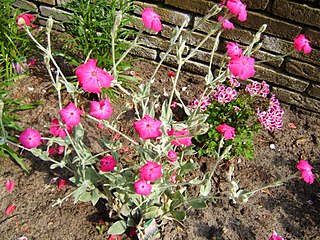
Anemone is a genus of flowering plants in the buttercup family Ranunculaceae. Plants of the genus are commonly called windflowers. They are native to the temperate and subtropical regions of all continents except Australia, New Zealand and Antarctica. The genus is closely related to several other genera including Anemonoides, Anemonastrum, Hepatica, and Pulsatilla. Some botanists include these genera within Anemone.

Brodiaea, also known by the common name cluster-lilies, is a monocot genus of flowering plants.

Anemone coronaria, the poppy anemone, Spanish marigold, or windflower, is a species of flowering plant in the buttercup family Ranunculaceae, native to the Mediterranean region.

Landsford Canal State Park is a South Carolina state park in Chester County, two miles (3.2 km) from US 21. The 448-acre (1.81 km2) park contains the ruins of the Landsford Canal built using slave labor to bypass rapids on the Catawba River between 1820 and 1825. The coming of the railroad caused the canal to be abandoned. The former lock keeper's house contains an interpretive museum. In addition to the canal, visitors also can see one of the largest remaining stands of Hymenocallis coronaria, the Shoals spider-lily, that grows in the shoals of the river and blooms from mid-May to mid-June. The park offers hiking, picnicking, boating, and fishing, as well as a playground.

Glebionis coronaria, formerly called Chrysanthemum coronarium, is a species of flowering plant in the daisy family. It is native to the Mediterranean region. It is cultivated and naturalized in East Asia and in scattered locations in North America.

Voacangine is an alkaloid found predominantly in the root bark of the Voacanga africana tree, as well as in other plants such as Tabernanthe iboga, Tabernaemontana africana, Trachelospermum jasminoides, Tabernaemontana divaricata and Ervatamia yunnanensis. It is an iboga alkaloid which commonly serves as a precursor for the semi-synthesis of ibogaine. It has been demonstrated in animals to have similar anti-addictive properties to ibogaine itself. It also potentiates the effects of barbiturates. Under UV-A and UV-B light its crystals fluoresce blue-green, and it is soluble in ethanol.

Silene coronaria, the rose campion, is a species of flowering plant in the family Caryophyllaceae, native to Asia and Europe. Other common names include dusty miller, mullein-pink and bloody William. In the United Kingdom it is still widely referenced under its synonym Lychnis coronaria.

Hymenocallis coronaria, commonly known as the Cahaba lily, shoal lily, or shoals spider-lily, is an aquatic, perennial flowering plant species of the genus Hymenocallis. It is endemic to the Southeastern United States, being found only in Alabama, Georgia, South Carolina and parts of North Carolina. Within Alabama, it is known as the Cahaba lily; elsewhere it is known as the Shoal lily or Shoals spider-lily.

Malus coronaria, also known by the names sweet crabapple or garland crab, is a North American species of Malus (crabapple). It grows primarily in the Great Lakes Region and in the Ohio Valley, with outlying populations as far away as Alabama, eastern Kansas, and Long Island.

Lasthenia coronaria is a species of flowering plant in the family Asteraceae known by the common name royal goldfields. It is native to California and Baja California, including Guadalupe Island.

Brodiaea coronaria is the type species of Brodiaea and also known by the common names harvest brodiaea and crown brodiaea. It is native to western North America from British Columbia to northern California, where it grows in mountains and grasslands.

Sarcosphaera is a fungal genus within the Pezizaceae family. It is a monotypic genus, containing the single species Sarcosphaera coronaria, commonly known as the pink crown, the violet crown-cup, or the violet star cup. It is a whitish or grayish cup fungus, distinguished by the manner in which the cup splits into lobes from the top downward. It is commonly found in the mountains in coniferous woods under humus on the forest floor, and often appears after the snow melts in late spring and early summer. The fungus is widespread, and has been collected in Europe, Israel and the Asian part of Turkey, North Africa, and North America. In Europe, it is considered a threatened species in 14 countries. Although several taxa have been described as Sarcosphaera species since the introduction of the genus in 1869, most lack modern descriptions, have been transferred to the related genus Peziza, or are considered synonymous with S. coronaria.

Coronaridine, also known as 18-carbomethoxyibogamine, is an alkaloid found in Tabernanthe iboga and related species, including Tabernaemontana divaricata for which it was named.

Stemorrhages sericea, the large emerald pearl, is a moth of the subfamily of Spilomelinae within the family Crambidae. It lives throughout Africa south of the Sahara, and the Indian Ocean islands of Réunion, Madagascar, Mauritius and the Comoros.

Affinisine is a monoterpenoid indole alkaloid which can be isolated from plants of the genus Tabernaemontana. Structurally, it can be considered a member of the sarpagine alkaloid family and may be synthesized from tryptophan via a Pictet-Spengler reaction.

Tabernaemontanine is a naturally occurring monoterpene indole alkaloid found in several species in the genus Tabernaemontana including Tabernaemontana divaricata.

Dregamine is a naturally occurring monoterpene indole alkaloid found in several species in the genus Tabernaemontana including Ervatamia hirta and Tabernaemontana divaricata.

Ervaticine is a 2-acylindole alkaloid. It occurs in Ervatamia coronaria and Tabernaemontana divaricata.

Voacristine is a indole alkaloid occurring in Voacanga and Tabernaemontana genus. It is also an iboga type alkaloid.



















